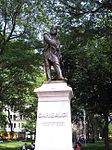Fales Library
New York University's Fales Library and Special Collections is located on the third floor of the Elmer Holmes Bobst Library at 70 Washington Square South between LaGuardia Place and the Schwartz Plaza, in the Greenwich Village neighborhood of Manhattan, New York City. It houses nearly 200,000 volumes, and 10,000 feet (3,000 m) of archive and manuscript materials. It contains the Fales Collection of rare books and manuscripts in English and American literature, the Downtown Collection, the Food and Cookery Collection, and the general Special Collections from the NYU Libraries. The Tracey-Barry Gallery offers public exhibits of materials from the Library's collections. The Fales Collection was given to NYU in 1957 by DeCoursey Fales in memory of his father, Haliburton Fales. It is especially strong in English literature from the middle of the 18th century to the present, documenting developments in the novel. Other related collections held in Fales include the Berol Collection of Lewis Carroll Materials, the Robert Frost Library, the Nelson F. Adkins collection of American Literature, and the manuscript collections of Elizabeth Robins, Peter Straub, E. L. Doctorow and Erich Maria Remarque. The Downtown Collection documents the downtown New York city art, performance, film, and literary landscape from 1975 to the present. In addition to thousands of published books and magazines, the Downtown Collection includes extensive holdings of archival and manuscript material; film and video; original artwork; theatrical models; and other realia. Archival holdings range from the personal papers of writers such as Dennis Cooper, Richard Foreman and Lynne Tillman to the papers of publishing ventures such as High Risk Books and Between C & D to the archives of organizations such as Creative Time and Mabou Mines and the Gonightclubbing Archive of late 1970s punk rock video, photos, interviews and ephemera. An area of recent growth in Fales is the Food and Cookery Collection of well over 15,000 books. The personal libraries of James Beard, Cecily Brownstone, and Dalia Carmel form the core of this collection which continues to expand. The Fales Library preserves manuscripts and original editions of books that are rare or important not only because of their texts, but also because of their value as artifacts. The Fales Library holds the personal papers and/or archives of the following, among others: John Canemaker Jerome Charyn Dennis Cooper E. L. Doctorow Richard Foreman Robert Hammond April Palmieri Elizabeth Robins Peter Straub Lynne Tillman David Wojnarowicz Kathleen Hanna Sarah Jacobson Pat Ivers Emily Armstrong
Excerpt from the Wikipedia article Fales Library (License: CC BY-SA 3.0, Authors).Fales Library
Washington Square North, New York Manhattan
Geographical coordinates (GPS) Address Nearby Places Show on map
Geographical coordinates (GPS)
| Latitude | Longitude |
|---|---|
| N 40.729663 ° | E -73.997014 ° |
Address
New York University
Washington Square North
10012 New York, Manhattan
New York, United States
Open on Google Maps



